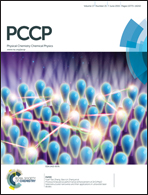Photoluminescence performance enhancement of ZnO/MgO heterostructured nanowires and their applications in ultraviolet laser diodes†
Abstract
Vertically aligned ZnO/MgO coaxial nanowire (NW) arrays were prepared on sapphire substrates by metal–organic chemical vapor deposition combined with a sputtering system. We present a comparative investigation of the morphological and optical properties of the produced heterostructures with different MgO layer thicknesses. Photoluminescence measurements showed that the optical performances of ZnO/MgO coaxial NWs were strongly dependent on the MgO layer thickness. The intensity of deep-level emission (DLE) decreased monotonously with the increase of MgO thickness, while the enhancement of ultraviolet (UV) emission showed a critical thickness of 15 nm, achieving a maximum intensity ratio (∼226) of IUV/IDLE at the same time. The significantly improved exciton emission efficiency of the coaxial NW structures allows us to study the surface passivation effect, photogenerated carrier confinement and transfer in terms of energy band theory. More importantly, we achieved an ultralow threshold (4.5 mA, 0.58 A cm−2) electrically driven UV lasing action based on the ZnO/MgO NW structures by constructing an Au/MgO/ZnO metal/insulator/semiconductor diode, and the continuous-current-driven diode shows a good temperature tolerance. The results obtained on the unique optical properties of ZnO/MgO coaxial NWs shed light on the design and development of ZnO-based UV laser diodes assembled with nanoscale building blocks.


 Please wait while we load your content...
Please wait while we load your content...